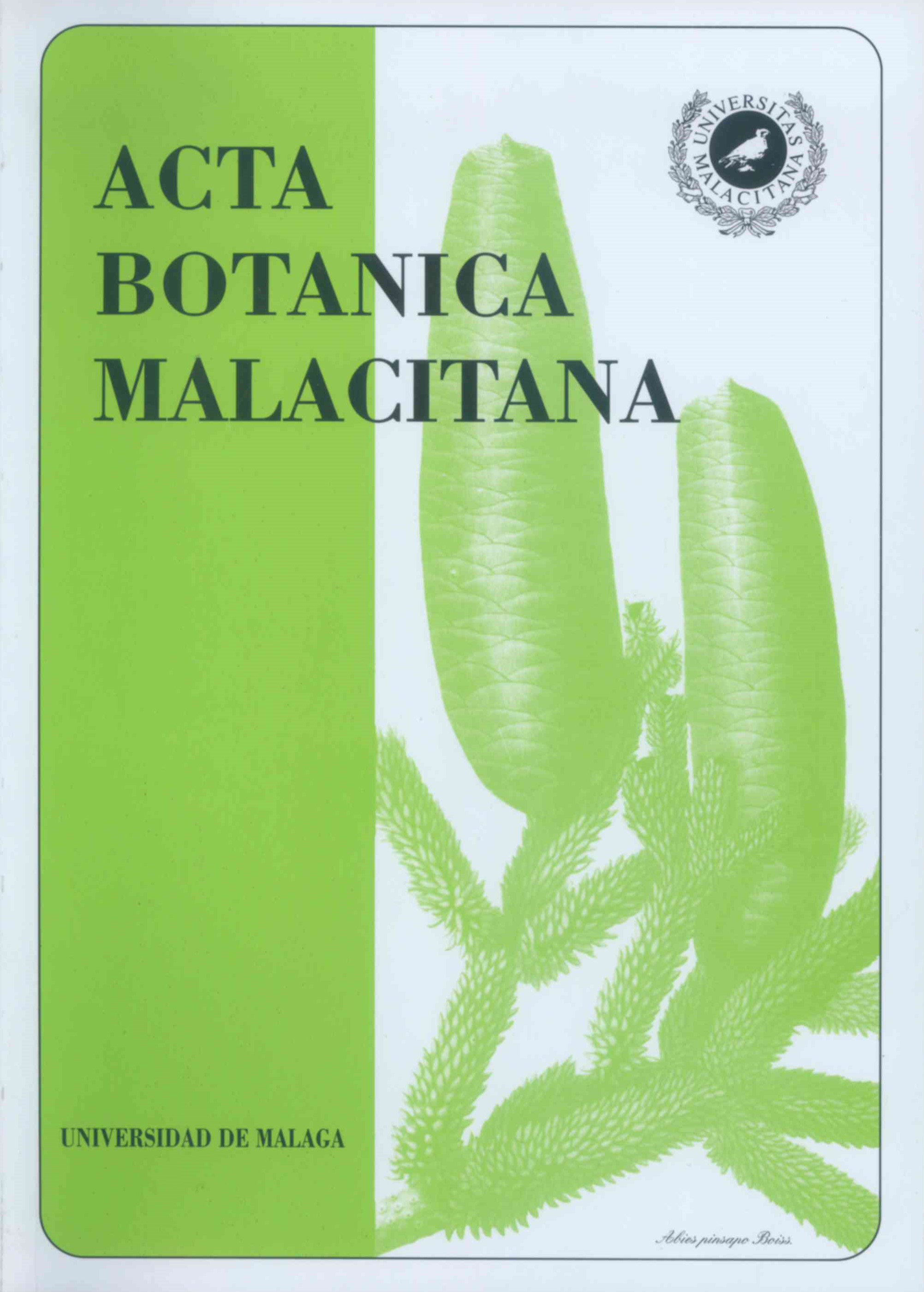The life cycles of cryptogams
DOI:
https://doi.org/10.24310/abm.v16i.9126Keywords:
Meiosis, gametogenesis, gametic fusion, dikaryotic condition, karyogamy, aberrant cycles, gene dosageAbstract
Meiosis and karyogamy are recognized as control points in the life cycle of cryptogams. The control of meiosis is evidently complex and in yeast, and by analogy in all cryptogams, involves progressive gene activation. The causes of the delay in meiosis in diplohaplontic and diplontic organisms, and the manner in which the block is removed remain to be discovered. There is accumulating evidence that cytoplasmic RNA plays an important role in meiotic division.
Many features of gametogenesis are still obscure. The tendency to oogamy has provided the opportunity for the laying down of long-lived messenger RNA in the abundant cytoplasm of the female gamete. The sporophytic nature of the developing zygote can in this way be partially pre-determined. There is evidence that this is the situation in the ferns.
Specific molecules (probably arabino-galacto-proteins) on the surface of the plasma membrane are likely to account both for gametic selection, and the readiness with which appropriate gametes fuse. The dikaryotic condition indicates that nuclear fusion is not inevitable following plasmogamy. The ultimate fusion of the nuclei may result from quite simple changes in the nuclear surface. Exposure of lipid, for example, would lead to fusion as a result of hydrophobic forces.
Aberrations of cryptogamic life cycles are numerous. The nuclear relationships of many aberrant cycles are unknown. In general it appears that the maintenance of sporophytic growth depends upon the presence of at least two sets of chromosomes. Conversely the maintenance of gametophytic growth in cultures obtained aposporously appears to be impossible in the presence of four sets of chromosomes, or more. These results raise important problems of the effect of gene dosage on development.
Downloads
Metrics
References
ADAIR, W.S. -1985- Characterization of Chlamydomonas sexual agglutinins. J. Cell Sci. Sppl. 2. 233-260.
BELL, P.R. -1989- The alternation of generations. Adv. Rot. Res., 16:55-93.
BISTIS, G.N. & J.R. RAPER -1963- Heterothallism and sexuality in Ascobolus stercorarius. Amer. J. Bot., 50:880-891.
BROADWATER, ST., J. SCOTT & B. POBINER -1986- Ultrastructure of meiosis in Dasya baillouviana (Rhodophyta). I. Prophase I. J. Phycol., 22:490-500.
BURNETT, J.H. -1976- Fundamentals of Mycology. Arnold, London.
CARLISLE, M.J. & L. MACHLIS -1965- The response of male gametes of Allomyces to the sexual hormone sirenin. Amer. J. Bot., 52:478-483.
CAVE, C.F. & P.R. BELL -1974- The synthesis of ribonucleic acid and protein during oogenesis in Pteridium aquilinum. Cytobiologie, 9:331-343.
DUBEL, S. -1985- Characterization of haploid Acetabularia cells. Eur. J. Cell Biol., 38:328- 334.
EMERSON, R. -1950- Current trends of experimental research on the aquatic phycomycetes. Ann. Rev. Microbiol., 4:169-200.
ESSER, K. -1976- Kryptogamen. Springer, Berlin.
EVANS, L.V., J.A. CALLOW & M.E. CALLOW -1982- The biology and biochemistry of reproduction and early development in Fucus. Prog. Phycol. Res., 1:67-110.
HAMILTON, R.C. -1989- Evidence of antheridiogen effect in naturally occurring gametophyte populations. Amer. J. Bot., 76:203.
HARVEY, W.H. & J.D. CAPONETTI -1972- In vitro studies on the induction of sporogenous tissue on leaves of the cinnamon fern. I. Environmental factors. Can.J. Rot., 50:2673-2682.
HEILBRONN, A. -1932- Polyploidie uncl Generationswechsel. Ber. dtsch. bot. Ges., 50:289- 299.
HOLLOWAY, B.L., D.J. LEHMAN, D.A. PRIMERANO, P.T. MAGEE & M.J. CLANCY - 1985- Sporulation-regulated genes of Saccharomyces cerevisiae. Curr. Genet., 10:163- 169.
HOMMERSAND, M.H. & J.A. WEST -1981- Rhodophyta: life histories. In: Lobban, C.S. & Wynne, M.J. (Eds.). The Biology of Seaweeds. Univ. Cal. Press, Berkeley & Los Angeles.
ITO, M. & M. MAEDA -1973- Fusion of meiotic protoplasts in liliaceous plants. Exptl. Cell Res., 80:453-455.
ITO, M. & M.H. TAKEGAMI -1982- Commitment of mitotic cells to meiosis during the G2 phase of premeiosis. Plant Cell Phys., 23:943-952.
JONES, J.L., J.A. CALLOW & J.R. GREEN -1988- Monoclonal antibodies to sperm surface antigens of the brown alga Fucus serratus exhibit region-, gamete-, species- and genus- preferential binding. Planta, 176:298-306.
MAINX, F. -1931- Physiologische und genetische Untersuchungen an Oedogonien. Z. Rot., 24:481-527.
MARTIN, N.C. & V.W. GOODENOUGH -1975- Gametic differentiation in Chlamydomonas reinhardii. I. Production of gametes and their fine structure. J. Cell Biol., 67:587-605.
MASUYAMA, S-1975- The sequence of the gametangium formation in homosporous fern gametophytes. Sci. Rep. Kyoilat Daigalat, Tokyo. Sec. B 16:47-69.
MEHRA, P.N. & L. KUMARI -1986- Induced meiotic reductions in root tips. III. Effect of pyrimidine derivatives and RNA. Cytologia, 51:457-466.
MITCHELL, A.P. & I HERSKOWITZ -1986- Activation of meiosis and sporulation by repression of the RME-1 product in yeast. Nature, 319:738-742.
SHEFFIELD, E. & P.R. BELL -1979- Ultrastructural aspects of sporogenesis in a fern, Pteridium aquilinum (L.) Kuhn. Ann. Bot., 44:293-405.
STEPHENSON. LW., D.C. ERWIN & J.V. LEARY -1974- Meiotic configurations in the oospore of Phytophthora capsici. Can. J. Bot., 52:2141-2143.
TANNER, C.E. -1981- Chlorophyta: life histories. In: Lobban, C.S. & Wynne, Mi. (Eds.) The Biology of Seaweeds Pp. 218-247. Univ. Cal. Press, Berkeley & Los Angeles.
TURIAN, G. -1961- Nucleic acids and sexual differentiation in Allomyces. Nature, 190:825. WALTERS, M.S. -1985- Meiosis readiness in Lilium. Can. J. Genet. Cytol., 27:33-38.
WETTSTEIN, F. VON -1942- Ober einige Beobachtungen und experimentelle Befunde bei Laubmoosen. Ber. dtsch. bot. Ges., 60:399-405.
Downloads
Published
How to Cite
Issue
Section
License
All information related to the licensing of published works in Acta Botanica Malacitana and copyright can be found in our Editorial Policy.







1.png)
